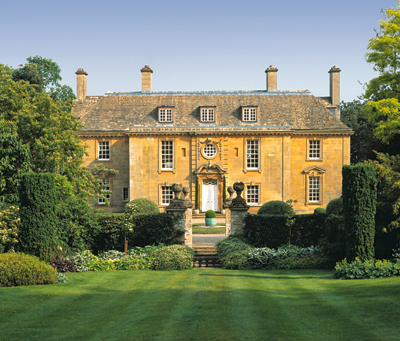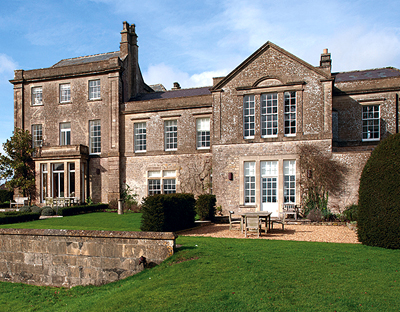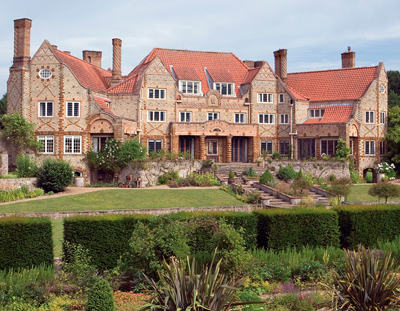England’s Favourite House: the winner
The winner of our competition to find England’s favourite house is finally revealed


Eyford takes the crown of England's Favourite House. Judges Emma Bridgewater, Annabel Astor, Charlie Brooks and Julian Fellowes selected the early-20th-century Cotswolds home out of a 150-strong field because ‘it is the quintessential country house for many generations'.
It may seem a surprising choice: Eyford is not the grandest, oldest or most architecturally significant of the entries. It's certainly not the most famous-at the judging lunch at The Ritz London last month, Lord Fellowes pointed out that it's refreshing to be able to reveal a new place to the public.But Eyford has that elusive quality, a homely warmth that simply makes you want to live there. This is testament to the skills of the family that has owned it for three generations.
Sir Cyril Kleinwort bought the estate in December 1972, and bequeathed it to his daughter, Charlotte Heber-Percy, who recently passed it on to her daughter, Serena Prest. Both ladies have cherished Eyford's historic heritage ‘about 60% of the carpets and curtains and 90% of the furniture are my grandmother's,' says Mrs Prest but neither has been afraid to turn it into a modern home.
Mr Brooks, who championed Eyford's cause at the judging lunch, said it combines the beauty of a historic building with the practicality of a modern home. ‘They have been bold in the way they have knocked down walls. You have lovely wide corridors and rooms where a million dogs or children can mill around.' The house has clearly grown with the family, with the top-floor rooms for the children, the converted stable block where Mrs Heber-Percy now lives and eclectic interiors that reflect the taste of three generations.
And if the hall's Ionic-style columns, the urn-encrusted staircase and the balustraded terraces overlooking a park add a touch of grandeur, quirky touches in the interiors dispel stuffiness. Mr Brooks's favourite was a series of murals, painted by Penelope Reeve in 2004, that depict the family in different Venetian settings and costumes. ‘And by the family, I mean the entire family, including the housekeeper,' he reveals.

The grounds, where, legend has it, John Milton began writing Paradise Lost, contribute much to Eyford's allure. ‘One of the most striking things about it is the approach, with long views of the house well before you reach it,' says Country Life's Deputy Editor, Rupert Uloth. ‘As you drive through the park, with unfenced fields on either side, grazing cows and calves complete the pastoral idyll.' A lake, tucked away in a valley beyond a mature wood, offers a haven for wildlife and a retreat for people.
The formal gardens, designed in Arts-and-Crafts style, then reworked by Graham Stuart Thomas for Sir Cyril in 1976 and, later, for Mrs Heber-Percy, are beautiful but manageable. Just as captivating are the woodland and little valleys that, Mr Uloth says, are perfect for a family shoot-adding to the considerable sporting appeal of being situated in the Heythrop Hunt's Saturday country.
Sign up for the Country Life Newsletter
Exquisite houses, the beauty of Nature, and how to get the most from your life, straight to your inbox.
But Eyford also harkens to Britain's deeply rooted love for Classicism. Although the house was only commissioned in 1911, architect Guy Dawber followed a late-17th-century style, whose classic lines-enlivened by Baroque details-so well chimed with the ‘simple and quiet manner' he favoured. Its ‘Quality Street Georgian design', as Country Life's Architectural Editor, John Goodall, calls it, never fails to appeal. This quiet domesticity, the fact that ‘the house has architectural presence without being too grand', as Mary Miers says in The English Country House, is what makes it such a favourite. We can all picture ourselves living there-and we would all like to.
The owner's view
I'm absolutely thrilled that Eyford has been named England's Favourite House,' says Mrs Prest. ‘When I heard the news, I jumped up and down (on my bed) with joy.' Mrs Prest says she always adored the house, even before it became hers. ‘I loved to come and stay here with my grandmother. I am very grateful to my grandparents and my mother, because I have been handed down a golden spoon.'
The three generations have all left a mark on the house-even Mrs Prest, who only moved there nine months ago with her husband, Rupert, and children Willa, Ivo and Fergus. ‘When my grandmother died, the house was very tired and the garden was falling apart,' she recalls. ‘My mother took it on with gusto and brought the whole place back to life.
What I've been trying to do is to modernise it and make it more child friendly. I hope we've hit the right note, with baths that work (they never really did in my grandmother's time) and yet none of that modern, hotel-like feel of interior design. Eyford is not a Chatsworth or a Blenheim-it only has six bedrooms-but it's really alive. Each day, I pinch myself at how lucky I am to live in such a beautiful, peaceful, yet practical house.'
Mrs Heber-Percy and Mrs Prest will be hosting a giant plant sale in aid of the ABF The Soldiers' Charity and the Countryside Alliance at Eyford on Sunday, May 22, from 10am to 4pm. About 25,000 plants and a wide variety of local produce will be available for sale. Other attractions will include a country-shopping village with live chickens and ducks, a sculpture garden, the Light Cavalry Military Band, and three media garden experts, who will be on hand to answer questions.
The judge's view
‘People don't particularly know about Eyford, but it really is a striking house,' says Mr Brooks, who selected the house as winner for his region, North and Central, before it was crowned overall winner. ‘If you go and have a look at it, you won't be disappointed.'
The estate agent's view
Crispin Holborow of Savills who, although not a judge, attended the judging lunch together with Louis de Soissons and Andrew Cronan, also of Savills, and Country Life's Editor, Mark Hedges, Deputy Editor Rupert Uloth, and Architectural Editor John Goodall-agrees that Eyford is ‘everyone's dream. Rolling parkland leads to a beautiful but manageable house, updated for family life, and one can easily imagine oneself living there. The warmth of the stone is so compelling, and the architecture so beguiling, you're misled into thinking it's Georgian, not Edwardian'.
The Editor's view
‘The search for England's Favourite House has taken the judges all over the country. Everywhere, they saw houses of the highest quality and charm, but, in the end, it came down to the house that they most wanted to live in and that house is Eyford-England's favourite house.'
The regional winners
Although Eyford won the England's Favourite House competition at national level, the judges felt that each region had some outstanding houses that embody the country-house idyll. Three in particular stood out above the rest-Southill House in Somerset, Voewood in Norfolk and Groombridge Place in Kent so judges awarded them the accolade of regional winner for, respectively, the South-West, the East and the South-East. Southill House, West Cranmore, Somerset
Lord Fellowes chose 18th-century Southill House as the regional winner for the South-West because it combines past and present so well. ‘The special gift of the English country house is for reinvention,' he says. ‘Each generation takes the tradition and makes it their own in a continuous stream of change and development. Southill is astonishingly successful as a traditional country house that has been perfectly equipped for modern living.
The gym, the cinema, the kitchen, with huge areas for sitting or dining, are all ideal for family life today, and yet they exist in perfect harmony with the cool Regency hall or the grand drawing room or the wonderful Edwardian billiard room, when the house party is in a more traditional mood. It is beautiful and comfortable, its setting is superb and convenient. In short, Southill is a remarkable achievement.'

Voewood, Holt, Norfolk
Miss Bridgewater says Voewood takes your breath away. The architecture is, of course, striking. Designed by E. S. Prior for Rev Percy Lloyd, it's a rare example of an Arts-and-Crafts butterfly- plan house. Miss Bridgewater says that ‘it looks like a Gaudí building in Barcelona'. But the interiors, rescued by owner Simon Finch after the house served as a school, and, later, as a rest home, are equally charming. He combined Arts-and-Crafts pieces with 1950s objets, tribal artefacts and contemporary art. The result is a ‘very welcoming' house, according to Miss Bridgewater. ‘It is the perfect combination, because it could suit a small family with children, but it could also stretch.'

Groombridge Place, Tunbridge Wells, Kent
From the moment we turned into a valley of pools, streams and woodlands and drove along the meandering drive to the front of the house, squeezing through grand gates guarding a small bridge over the moat, I fell in love with Groombridge Place,' says Lady Astor. ‘The buildings have hardly been touched for more than 350 years, bar some convenience modernisations and a conservatory extension linking an outhouse to the kitchen.' What most impressed her was that ‘when looking from the windows of each room from each floor and from each side, every aspect offered a glorious view without a blemish.
This was not a result of over-manicured grounds, but an unstructured evolution of the landscape, planting and building'. In short: ‘Groombridge is a model of perfection. Its history and beauty are mesmerising, the setting is magical and it is an ideal home for intimate family life. It's an oasis for all seasons and future generations.'

Country Life is unlike any other magazine: the only glossy weekly on the newsstand and the only magazine that has been guest-edited by HRH The King not once, but twice. It is a celebration of modern rural life and all its diverse joys and pleasures — that was first published in Queen Victoria's Diamond Jubilee year. Our eclectic mixture of witty and informative content — from the most up-to-date property news and commentary and a coveted glimpse inside some of the UK's best houses and gardens, to gardening, the arts and interior design, written by experts in their field — still cannot be found in print or online, anywhere else.
-
 Two quick and easy seasonal asparagus recipes to try this Easter Weekend
Two quick and easy seasonal asparagus recipes to try this Easter WeekendAsparagus has royal roots — it was once a favourite of Madame de Pompadour.
By Melanie Johnson
-
 Sip tea and laugh at your neighbours in this seaside Norfolk home with a watchtower
Sip tea and laugh at your neighbours in this seaside Norfolk home with a watchtowerOn Cliff Hill in Gorleston, one home is taller than all the others. It could be yours.
By James Fisher